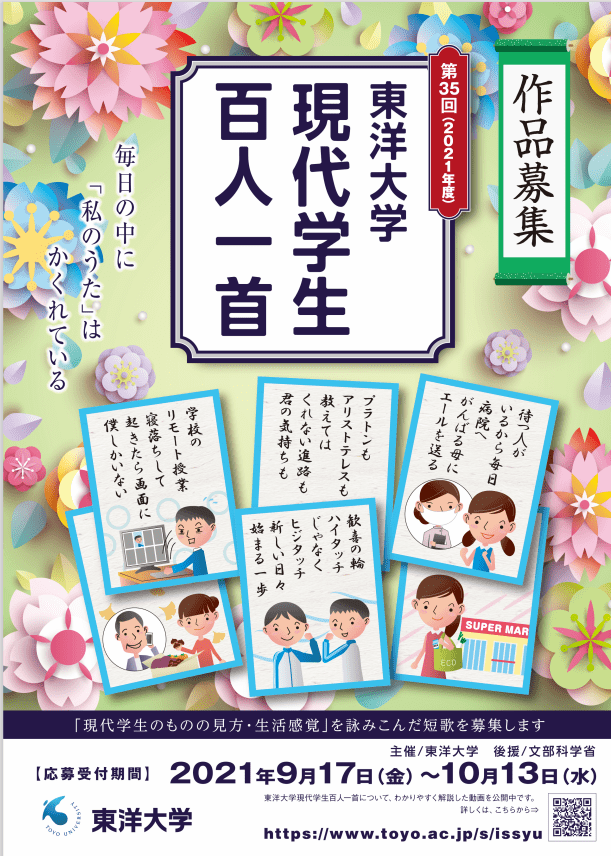The 35th Toyo University 1000 Poems of Modern Students Contest
Competition

Greetings ITS Students!
We are happy to inform you, one of Toyo University’s annual event called Gendai Gakusei Hyakunin Isshu, a poem contest is now open to students. We encourage the contestants to express their ways of viewing daily life, everyday sentiments and feelings in a traditional Japanese fixed-form poem called tanka (see No.6 below). The 34th contest held in 2020 drew a total of 65,499 poems. Mark the dates and join the contest!
1. Enter Period
Friday, 17 September 2021 – Wednesday, 13 October 2021 (both dates inclusive)
2. How to apply
Write your poem and the required information in the attached application form, convert the file into a PDF, and send it to the address below.
3. E-mail address
mlkoho@toyo.jp
(PR Section, General Affairs Dept., Toyo University)
4. What is Hyakunin Isshu?
In Japan, word play in a style similar to that of tanka began around the 7th century. Since then, the art of poetry composition developed among the country’s ruling class and at court. During Japan’s Middle Ages, from the Heian to Kamakura era (794-1333 CE), one hundred poems by noted authors were compiled into a collection called Hyakunin Isshu (literal translation: “one hundred persons, one poem each“). Hyakunin Isshu still exists and popular in Japan as a form of traditional culture, one well-known collection being widely used in a New Year’s card game.
Modeling this anthology on the Hyakunin Isshu, Toyo University openly solicits tanka poems from students and selects the best 100 entries that express their fresh sensibilities and trends of the times.
5. What is Gendai Gakusei Hyakunin Isshu ?
Gendai Gakusei Hyakunin Isshu (One Hundred Poems of Modern Students) Contest began in 1987 as a Toyo University centennial commemorative event. In 2021, its 35th will be held. The total number of tanka poems entered in the previous contests, expressing present-day students’ views of the world and their daily life, has reached over 1.5 million.
6. What is tanka ?
Tanka is a fixed-form poem composed of 31 Japanese units of sound (31-mora) in total that can be divided into phrases of 5-7-5-7-7 sounds to express one’s feelings and impressions in a daily situation. One unit of sound corresponds to one kana character.
For example, 「沖縄で 海にもぐって 魚とり あの海へびは おそろしかった」(Okinawa-de umi-ni mogutte sakana tori ano umihebi-wa osoroshikatta – In Okinawa, I dove into the sea and caught fish; that sea snake was scary) comprises phrases of 5 sounds (o-ki-na-wa-de), 7 sounds (u-mi-ni-mo-gu-t-te), 5 sounds (sa-ka-na-to-ri), 7 sounds (a-no-u-mi-he-bi-wa), and 7 sounds (o-so-ro-shi-ka-t-ta) . A good tanka poem makes a creative use of characteristics of the Japanese language and enables the reader to vividly imagine the scene depicted or sympathize with the author’s feelings expressed.
Click here for application guide
Click here for application form
Contact :
mlkoho@toyo.jp (Public Relations Section, Toyo University)
Latest News
-
SATU SMART 5th International Innovation Competition
Dear ITS Students, We are excited to inform you that the 2023 SATU SMART 5th International Innovation
-
The 9th China International College Students’ “Internet +” Innovation and Entrepreneurship Competition
Dear ITS Students, Let’s join the world-class event that celebrates innovation and entrepreneurship. This prestigious competition, jointly organized by
-
2nd ASEAN-China Student Rowing Competition
Dear ITS Students, Tianjin University is pleased to invite you to the 2nd ASEAN-China Student Rowing Competition which will





